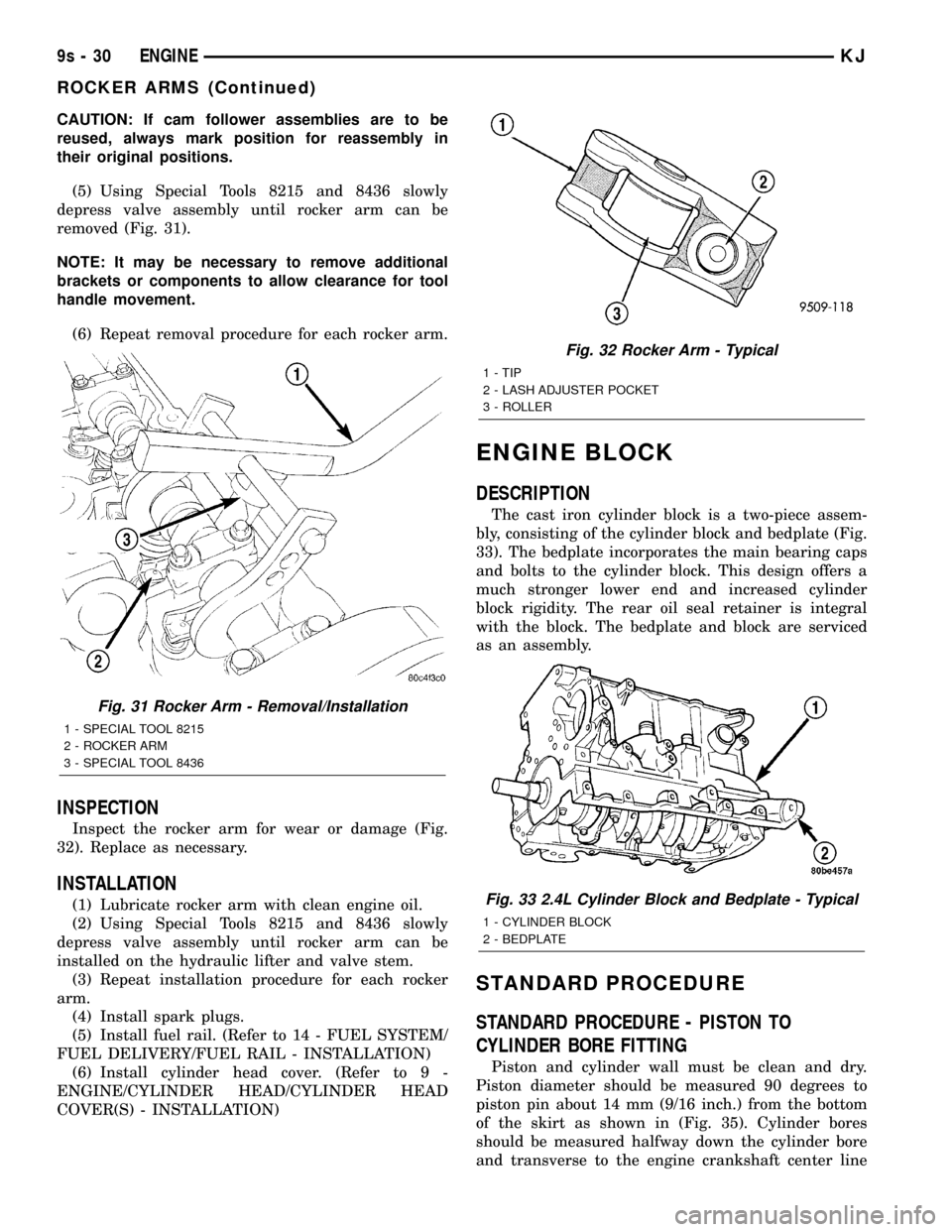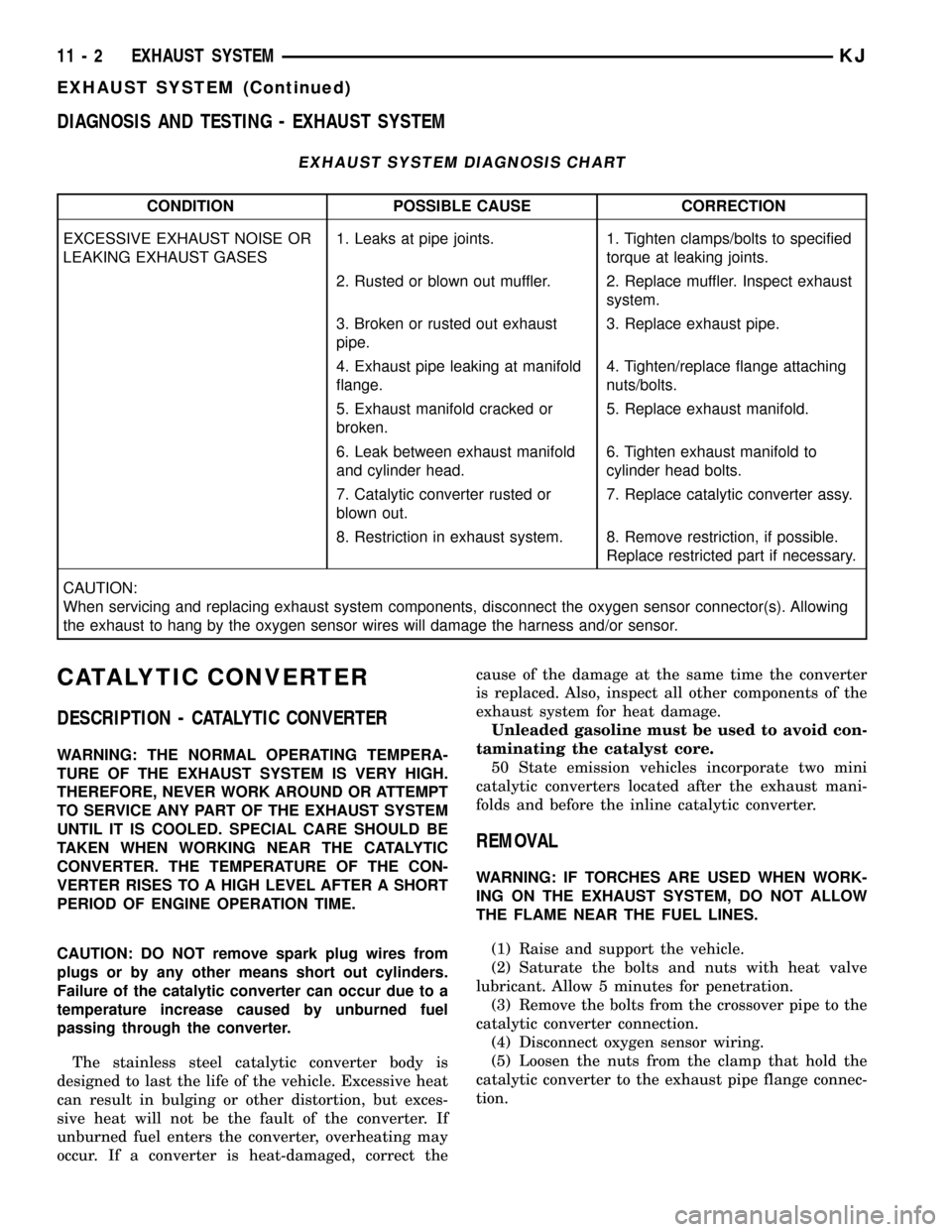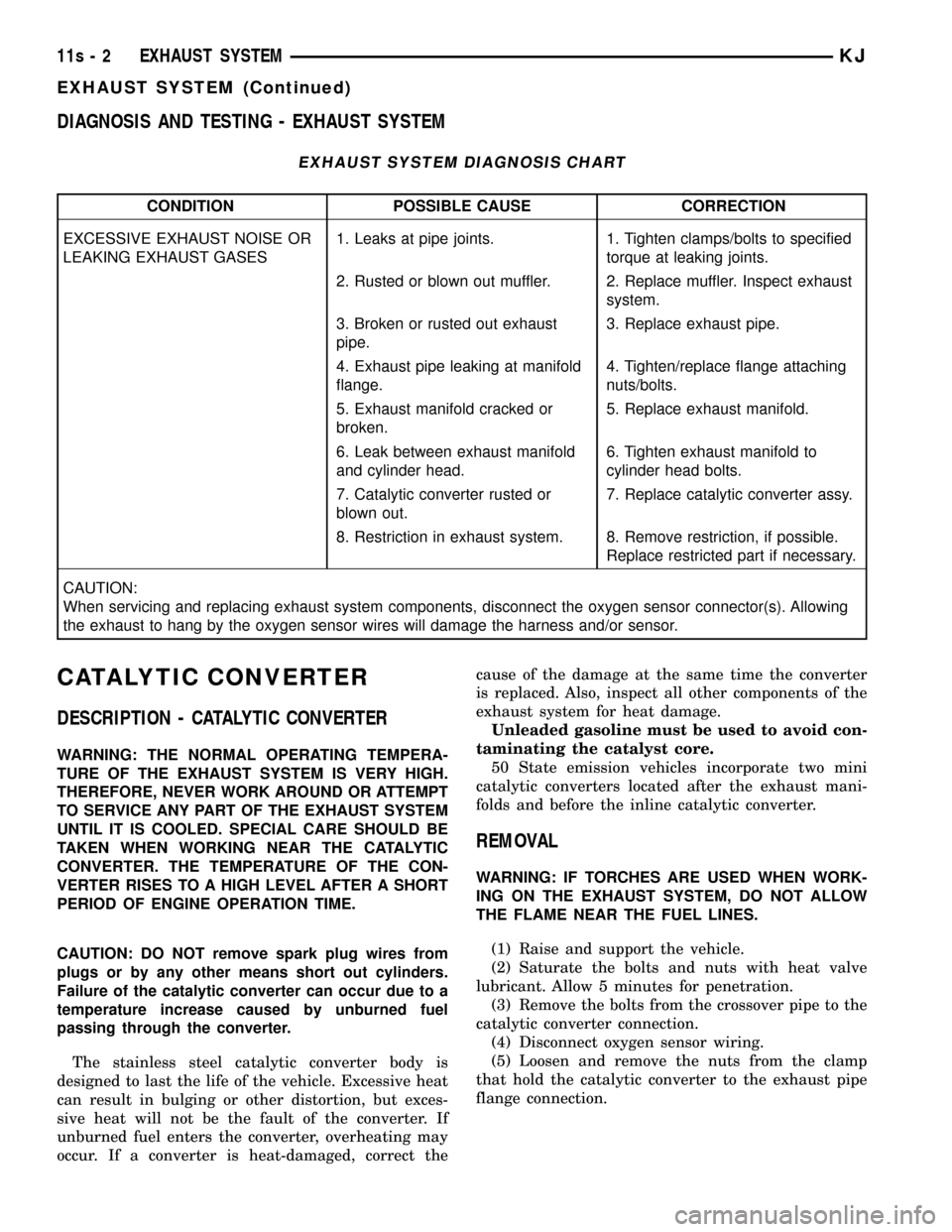2002 JEEP LIBERTY spark plugs replace
[x] Cancel search: spark plugs replacePage 1325 of 1803

INSPECTION
(1) Whenever valves have been removed for inspec-
tion, reconditioning or replacement, valve springs
should be tested for correct tension. Discard the
springs that do not meet specifications. The following
specifications apply to both intake and exhaust
valves springs:
²Valve Closed Nominal TensionÐ76 lbs. @ 38.0
mm (1.50 in.)
²Valve Open Nominal TensionÐ136 lbs. @ 29.75
mm (1.17 in.)
(2) Inspect each valve spring for squareness with a
steel square and surface plate, test springs from both
ends. If the spring is more than 1.5 mm (1/16 inch)
out of square, install a new spring.
INSTALLATION
INSTALLATION - CYLINDER HEAD ON
(1) Install valve seal/valve spring seat assembly
(Fig. 27). Push the assembly down to seat it onto the
valve guide.
(2) Install valve spring and retainer, use Special
Tool MD-998772-A with adapter 6779 to compress
valve springs only enough to install locks. Correct
alignment of tool is necessary to avoid nicking valve
stems.
(3) Remove air hose and install spark plugs.
(4) Install camshafts and cylinder head cover .
INSTALLATION - CYLINDER HEAD OFF
(1) Coat valve stems with clean engine oil and
insert in cylinder head.(2) Install new valve stem seals on all valves
using a valve stem seal tool (Fig. 28). The valve stem
seals should be pushed firmly and squarely over
valve guide.
CAUTION: When oversize valves are used, the cor-
responding oversize valve seal must also be used.
Excessive guide wear may result if oversize seals
are not used with oversize valves.
(3) Install valve springs and retainers. Compress
valve springs only enough to install locks, taking
care not to misalign the direction of compression.
Nicked valve stems may result from misalignment of
the valve spring compressor.
CAUTION: When depressing the valve spring retain-
ers with valve spring compressor the locks can
become dislocated. Ensure both locks are in the
correct location after removing tool.
(4) Check the valve spring installed height B after
refacing the valve and seat (Fig. 29). Make sure mea-
surements are taken from top of spring seat to the
bottom surface of spring retainer. If height is greater
than 38.75 mm (1.525 in.), install a 0.762 mm (0.030
in.) spacer under the valve spring seat to bring
spring height back within specification.
HYDRAULIC LIFTERS
DIAGNOSIS AND TESTING - LASH ADJUSTER
(TAPPET) NOISE DIAGNOSIS
A tappet-like noise may be produced from several
items. Check the following items.
(1) Engine oil level too high or too low. This may
cause aerated oil to enter the adjusters and cause
them to be spongy.
Fig. 27 Valve Stem Seal/Valve Spring Seat - Typical
1 - 3-GROOVE -VALVE RETAINING LOCKS
2 - VALVE SPRING
3 - VALVE SEAL AND VALVE SPRING SEAT ASSEMBLY
4 - VALVE SPRING RETAINER
Fig. 28 Valve Stem Oil Seal Tool
1 - VALVE SEAL TOOL
2 - VALVE STEM
9s - 28 ENGINEKJ
VALVE SPRINGS (Continued)
Page 1326 of 1803

(2) Insufficient running time after rebuilding cylin-
der head. Low speed running up to 1 hour may be
required.
(3) During this time, turn engine off and let set for
a few minutes before restarting. Repeat this several
times after engine has reached normal operating
temperature.
(4) Low oil pressure.
(5) The oil restrictor (integral to the head gasket)
in the vertical oil passage to the cylinder head is
plugged with debris.
(6) Air ingested into oil due to broken or cracked
oil pump pick up.
(7) Worn valve guides.
(8) Rocker arm ears contacting valve spring
retainer.
(9) Rocker arm loose, adjuster stuck or at maxi-
mum extension and still leaves lash in the system.
(10) Faulty lash adjuster.
a. Check lash adjusters for sponginess while
installed in cylinder head. Depress part of rocker
arm over adjuster. Normal adjusters should feel very
firm. Spongy adjusters can be bottomed out easily.
b. Remove suspected lash adjusters, and replace as
necessary.
REMOVAL
NOTE: This procedure is for in-vehicle service with
camshafts installed.
(1) Remove cylinder head cover. (Refer to 9 -
ENGINE/CYLINDER HEAD/CYLINDER HEAD
COVER(S) - REMOVAL)
(2) Remove the camshafts (Refer to 9 - ENGINE/
CYLINDER HEAD/CAMSHAFT(S) - REMOVAL).
(3) Remove rocker arm. (Refer to 9 - ENGINE/
CYLINDER HEAD/ROCKER ARMS - REMOVAL)
(4) Remove hydraulic lifter (Fig. 30).(5) Repeat removal procedure for each hydraulic
lifter.
(6) If reusing, mark each hydraulic lifter for reas-
sembly in original position. Lifters are serviced as an
assembly.
INSTALLATION
(1) Install hydraulic lifter (Fig. 30). Ensure the
lifters are at least partially full of engine oil. This is
indicated by little or no plunger travel when the
lifter is depressed.
(2) Install rocker arm. (Refer to 9 - ENGINE/CYL-
INDER HEAD/ROCKER ARMS - INSTALLATION)
(3) Repeat installation procedure for each hydrau-
lic lifter.
(4) Install camshafts (Refer to 9 - ENGINE/CYL-
INDER HEAD/CAMSHAFT(S) - INSTALLATION).
(5) Install cylinder head cover. (Refer to 9 -
ENGINE/CYLINDER HEAD/CYLINDER HEAD
COVER(S) - INSTALLATION)
ROCKER ARMS
REMOVAL
NOTE: This procedure is for in-vehicle service with
camshafts installed.
(1) Remove cylinder head cover. (Refer to 9 -
ENGINE/CYLINDER HEAD/CYLINDER HEAD
COVER(S) - REMOVAL)
(2) Remove fuel rail. (Refer to 14 - FUEL SYS-
TEM/FUEL DELIVERY/FUEL RAIL - REMOVAL)
(3) Remove spark plugs.
(4) Rotate engine until the camshaft lobe, on the
follower being removed, is position on its base circle
(heel). Also, the piston should be a minimum of 6.3
mm (0.25 in) below TDC position.
Fig. 29 Checking Spring Installed Height and Valve
Tip Height Dimensions
1 - GARTER SPRING
2 - VALVE SPRING SEAT
3 - CYLINDER HEAD SURFACE
Fig. 30 Hydraulic Lash Adjuster
KJENGINE9s-29
HYDRAULIC LIFTERS (Continued)
Page 1327 of 1803

CAUTION: If cam follower assemblies are to be
reused, always mark position for reassembly in
their original positions.
(5) Using Special Tools 8215 and 8436 slowly
depress valve assembly until rocker arm can be
removed (Fig. 31).
NOTE: It may be necessary to remove additional
brackets or components to allow clearance for tool
handle movement.
(6) Repeat removal procedure for each rocker arm.
INSPECTION
Inspect the rocker arm for wear or damage (Fig.
32). Replace as necessary.
INSTALLATION
(1) Lubricate rocker arm with clean engine oil.
(2) Using Special Tools 8215 and 8436 slowly
depress valve assembly until rocker arm can be
installed on the hydraulic lifter and valve stem.
(3) Repeat installation procedure for each rocker
arm.
(4) Install spark plugs.
(5) Install fuel rail. (Refer to 14 - FUEL SYSTEM/
FUEL DELIVERY/FUEL RAIL - INSTALLATION)
(6) Install cylinder head cover. (Refer to 9 -
ENGINE/CYLINDER HEAD/CYLINDER HEAD
COVER(S) - INSTALLATION)
ENGINE BLOCK
DESCRIPTION
The cast iron cylinder block is a two-piece assem-
bly, consisting of the cylinder block and bedplate (Fig.
33). The bedplate incorporates the main bearing caps
and bolts to the cylinder block. This design offers a
much stronger lower end and increased cylinder
block rigidity. The rear oil seal retainer is integral
with the block. The bedplate and block are serviced
as an assembly.
STANDARD PROCEDURE
STANDARD PROCEDURE - PISTON TO
CYLINDER BORE FITTING
Piston and cylinder wall must be clean and dry.
Piston diameter should be measured 90 degrees to
piston pin about 14 mm (9/16 inch.) from the bottom
of the skirt as shown in (Fig. 35). Cylinder bores
should be measured halfway down the cylinder bore
and transverse to the engine crankshaft center line
Fig. 31 Rocker Arm - Removal/Installation
1 - SPECIAL TOOL 8215
2 - ROCKER ARM
3 - SPECIAL TOOL 8436
Fig. 32 Rocker Arm - Typical
1 - TIP
2 - LASH ADJUSTER POCKET
3 - ROLLER
Fig. 33 2.4L Cylinder Block and Bedplate - Typical
1 - CYLINDER BLOCK
2 - BEDPLATE
9s - 30 ENGINEKJ
ROCKER ARMS (Continued)
Page 1363 of 1803

DIAGNOSIS AND TESTING - EXHAUST SYSTEM
EXHAUST SYSTEM DIAGNOSIS CHART
CONDITION POSSIBLE CAUSE CORRECTION
EXCESSIVE EXHAUST NOISE OR
LEAKING EXHAUST GASES1. Leaks at pipe joints. 1. Tighten clamps/bolts to specified
torque at leaking joints.
2. Rusted or blown out muffler. 2. Replace muffler. Inspect exhaust
system.
3. Broken or rusted out exhaust
pipe.3. Replace exhaust pipe.
4. Exhaust pipe leaking at manifold
flange.4. Tighten/replace flange attaching
nuts/bolts.
5. Exhaust manifold cracked or
broken.5. Replace exhaust manifold.
6. Leak between exhaust manifold
and cylinder head.6. Tighten exhaust manifold to
cylinder head bolts.
7. Catalytic converter rusted or
blown out.7. Replace catalytic converter assy.
8. Restriction in exhaust system. 8. Remove restriction, if possible.
Replace restricted part if necessary.
CAUTION:
When servicing and replacing exhaust system components, disconnect the oxygen sensor connector(s). Allowing
the exhaust to hang by the oxygen sensor wires will damage the harness and/or sensor.
CATALYTIC CONVERTER
DESCRIPTION - CATALYTIC CONVERTER
WARNING: THE NORMAL OPERATING TEMPERA-
TURE OF THE EXHAUST SYSTEM IS VERY HIGH.
THEREFORE, NEVER WORK AROUND OR ATTEMPT
TO SERVICE ANY PART OF THE EXHAUST SYSTEM
UNTIL IT IS COOLED. SPECIAL CARE SHOULD BE
TAKEN WHEN WORKING NEAR THE CATALYTIC
CONVERTER. THE TEMPERATURE OF THE CON-
VERTER RISES TO A HIGH LEVEL AFTER A SHORT
PERIOD OF ENGINE OPERATION TIME.
CAUTION: DO NOT remove spark plug wires from
plugs or by any other means short out cylinders.
Failure of the catalytic converter can occur due to a
temperature increase caused by unburned fuel
passing through the converter.
The stainless steel catalytic converter body is
designed to last the life of the vehicle. Excessive heat
can result in bulging or other distortion, but exces-
sive heat will not be the fault of the converter. If
unburned fuel enters the converter, overheating may
occur. If a converter is heat-damaged, correct thecause of the damage at the same time the converter
is replaced. Also, inspect all other components of the
exhaust system for heat damage.
Unleaded gasoline must be used to avoid con-
taminating the catalyst core.
50 State emission vehicles incorporate two mini
catalytic converters located after the exhaust mani-
folds and before the inline catalytic converter.
REMOVAL
WARNING: IF TORCHES ARE USED WHEN WORK-
ING ON THE EXHAUST SYSTEM, DO NOT ALLOW
THE FLAME NEAR THE FUEL LINES.
(1) Raise and support the vehicle.
(2) Saturate the bolts and nuts with heat valve
lubricant. Allow 5 minutes for penetration.
(3) Remove the bolts from the crossover pipe to the
catalytic converter connection.
(4) Disconnect oxygen sensor wiring.
(5) Loosen the nuts from the clamp that hold the
catalytic converter to the exhaust pipe flange connec-
tion.
11 - 2 EXHAUST SYSTEMKJ
EXHAUST SYSTEM (Continued)
Page 1369 of 1803

DIAGNOSIS AND TESTING - EXHAUST SYSTEM
EXHAUST SYSTEM DIAGNOSIS CHART
CONDITION POSSIBLE CAUSE CORRECTION
EXCESSIVE EXHAUST NOISE OR
LEAKING EXHAUST GASES1. Leaks at pipe joints. 1. Tighten clamps/bolts to specified
torque at leaking joints.
2. Rusted or blown out muffler. 2. Replace muffler. Inspect exhaust
system.
3. Broken or rusted out exhaust
pipe.3. Replace exhaust pipe.
4. Exhaust pipe leaking at manifold
flange.4. Tighten/replace flange attaching
nuts/bolts.
5. Exhaust manifold cracked or
broken.5. Replace exhaust manifold.
6. Leak between exhaust manifold
and cylinder head.6. Tighten exhaust manifold to
cylinder head bolts.
7. Catalytic converter rusted or
blown out.7. Replace catalytic converter assy.
8. Restriction in exhaust system. 8. Remove restriction, if possible.
Replace restricted part if necessary.
CAUTION:
When servicing and replacing exhaust system components, disconnect the oxygen sensor connector(s). Allowing
the exhaust to hang by the oxygen sensor wires will damage the harness and/or sensor.
CATALYTIC CONVERTER
DESCRIPTION - CATALYTIC CONVERTER
WARNING: THE NORMAL OPERATING TEMPERA-
TURE OF THE EXHAUST SYSTEM IS VERY HIGH.
THEREFORE, NEVER WORK AROUND OR ATTEMPT
TO SERVICE ANY PART OF THE EXHAUST SYSTEM
UNTIL IT IS COOLED. SPECIAL CARE SHOULD BE
TAKEN WHEN WORKING NEAR THE CATALYTIC
CONVERTER. THE TEMPERATURE OF THE CON-
VERTER RISES TO A HIGH LEVEL AFTER A SHORT
PERIOD OF ENGINE OPERATION TIME.
CAUTION: DO NOT remove spark plug wires from
plugs or by any other means short out cylinders.
Failure of the catalytic converter can occur due to a
temperature increase caused by unburned fuel
passing through the converter.
The stainless steel catalytic converter body is
designed to last the life of the vehicle. Excessive heat
can result in bulging or other distortion, but exces-
sive heat will not be the fault of the converter. If
unburned fuel enters the converter, overheating may
occur. If a converter is heat-damaged, correct thecause of the damage at the same time the converter
is replaced. Also, inspect all other components of the
exhaust system for heat damage.
Unleaded gasoline must be used to avoid con-
taminating the catalyst core.
50 State emission vehicles incorporate two mini
catalytic converters located after the exhaust mani-
folds and before the inline catalytic converter.
REMOVAL
WARNING: IF TORCHES ARE USED WHEN WORK-
ING ON THE EXHAUST SYSTEM, DO NOT ALLOW
THE FLAME NEAR THE FUEL LINES.
(1) Raise and support the vehicle.
(2) Saturate the bolts and nuts with heat valve
lubricant. Allow 5 minutes for penetration.
(3) Remove the bolts from the crossover pipe to the
catalytic converter connection.
(4) Disconnect oxygen sensor wiring.
(5) Loosen and remove the nuts from the clamp
that hold the catalytic converter to the exhaust pipe
flange connection.
11s - 2 EXHAUST SYSTEMKJ
EXHAUST SYSTEM (Continued)
Page 1745 of 1803

COMPASS CALIBRATION - STANDARD
PROCEDURE.........................8M-2
COMPASS DEMAGNETIZING -
STANDARD PROCEDURE...............8M-2
COMPASS MINI-TRIP COMPUTER -
DIAGNOSIS AND TESTING..............8M-6
COMPASS MINI-TRIP ILLUMINATION
BULB - INSTALLATION................8L-75
COMPASS MINI-TRIP ILLUMINATION
BULB - REMOVAL....................8L-74
COMPASS VARIATION ADJUSTMENT -
STANDARD PROCEDURE...............8M-3
COMPASS/MINI-TRIP COMPUTER -
DESCRIPTION........................8M-4
COMPASS/MINI-TRIP COMPUTER -
INSTALLATION.......................8M-8
COMPASS/MINI-TRIP COMPUTER -
OPERATION.........................8M-5
COMPASS/MINI-TRIP COMPUTER -
REMOVAL...........................8M-7
COMPRESSION PRESSURE - DIAGNOSIS
AND TESTING, CYLINDER................9-8
COMPRESSOR CLUTCH - INSPECTION,
A/C................................24-14
COMPRESSOR CLUTCH - INSTALLATION,
A/C................................24-14
COMPRESSOR CLUTCH - REMOVAL, A/C . . 24-13
COMPRESSOR CLUTCH BREAK-IN -
STANDARD PROCEDURE, A/C...........24-12
COMPRESSOR CLUTCH COIL -
DIAGNOSIS AND TESTING, A/C..........24-12
COMPRESSOR CLUTCH RELAY -
DESCRIPTION, A/C...................24-15
COMPRESSOR CLUTCH RELAY -
DIAGNOSIS AND TESTING.............24-15
COMPRESSOR CLUTCH RELAY -
INSTALLATION, A/C...................24-16
COMPRESSOR CLUTCH RELAY -
OPERATION, A/C.....................24-15
COMPRESSOR CLUTCH RELAY -
REMOVAL, A/C......................24-16
COMPRESSOR NOISE - DIAGNOSIS AND
TESTING, A/C.......................24-42
COMPUTER - DESCRIPTION, COMPASS/
MINI-TRIP..........................8M-4
COMPUTER - DIAGNOSIS AND TESTING,
COMPASS MINI-TRIP..................8M-6
COMPUTER - INSTALLATION, COMPASS/
MINI-TRIP..........................8M-8
COMPUTER - OPERATION, COMPASS/
MINI-TRIP..........................8M-5
COMPUTER - REMOVAL, COMPASS/
MINI-TRIP..........................8M-7
CONDENSER - DESCRIPTION, A/C.......24-45
CONDENSER - INSTALLATION, A/C.......24-46
CONDENSER - OPERATION, A/C.........24-45
CONDENSER - REMOVAL, A/C..........24-45
CONDITIONER - DESCRIPTION, HEATER
AND AIR ............................24-1
CONDITIONER - OPERATION, HEATER
AND AIR ............................24-2
CONDITIONS - DIAGNOSIS AND
TESTING, SPARK PLUG................8I-13
CONNECT FITTING - DESCRIPTION,
QUICK.............................14-10
CONNECTING ROD - DESCRIPTION,
PISTON.............................9-49
CONNECTING ROD BEARING - FITTING -
STANDARD PROCEDURE................9-40
CONNECTING ROD BEARING, FITTING.....9-49
CONNECTOR - DESCRIPTION, DATA LINK . 8E-10
CONNECTOR - INSTALLATION
.......8W-01-11
CONNECTOR - INSTALLATION, TRAILER
TOW
..............................8L-61
CONNECTOR - OPERATION, DATA LINK
. . . 8E-10
CONNECTOR - REMOVAL
...........8W-01-11
CONNECTOR - REMOVAL, TRAILER TOW
. . 8L-61
CONNECTOR, GROUND AND SPLICE
INFORMATION - DESCRIPTION
........8W-01-7
CONNECTOR/GROUND/SPLICE LOCATION
- DESCRIPTION
....................8W-91-1
CONSOLE - DESCRIPTION, OVERHEAD
....8M-1
CONSOLE - INSTALLATION, FLOOR
.....23-158
CONSOLE - OPERATION, OVERHEAD
......8M-2
CONSOLE - REMOVAL, FLOOR
.........23-158
CONSOLE DUCT - INSTALLATION, FLOOR
. 24-31
CONSOLE DUCT - REMOVAL, FLOOR
.....24-31CONSOLE LID LATCH - INSTALLATION,
FLOOR............................23-158
CONSOLE LID LATCH - REMOVAL,
FLOOR............................23-158
CONSOLE, REMOVAL - OVERHEAD.......8M-4
CONTAINER - DESCRIPTION, COOLANT
RECOVERY PRESS....................7-19
CONTAINER - OPERATION, COOLANT
RECOVERY PRESS....................7-19
CONTAMINATION - DIAGNOSIS AND
TESTING, BRAKE FLUID................5-26
CONTAMINATION - DIAGNOSIS AND
TESTING, FLUID....................21-125
CONTINUITY - STANDARD PROCEDURE,
TESTING.........................8W-01-9
CONTROL - DESCRIPTION, A/C HEATER . . . 24-16
CONTROL - DESCRIPTION, IGNITION......8I-1
CONTROL - DESCRIPTION, SPEED........8P-1
CONTROL - INSTALLATION, A/C HEATER . . 24-17
CONTROL - OPERATION, IGNITION........8I-1
CONTROL - OPERATION, SPEED..........8P-1
CONTROL - REMOVAL, A/C HEATER......24-17
CONTROL - TORQUE, SPEED............8P-2
CONTROL ARM - DESCRIPTION, LOWER . . . 2-21
CONTROL ARM - INSTALLATION, LOWER . . 2-10,
2-21
CONTROL ARM - INSTALLATION, UPPER . . . 2-21
CONTROL ARM - OPERATION, LOWER.....2-21
CONTROL ARM - REMOVAL, LOWER . . 2-10,2-21
CONTROL ARM - REMOVAL, UPPER......2-20
CONTROL ASSEMBLY WINDOW
DEFOGGER FUNCTION - DIAGNOSIS
AND TESTING, REAR HVAC.............8G-9
CONTROL CABLE - INSTALLATION,
THROTTLE..........................14-46
CONTROL CABLE - REMOVAL,
THROTTLE..........................14-45
CONTROL ILLUMINATION BULB -
INSTALLATION, HEATER-A/C............8L-78
CONTROL ILLUMINATION BULB -
REMOVAL, HEATER-A/C...............8L-78
CONTROL INFORMATION (VECI) LABEL -
DESCRIPTION, VEHICLE EMISSION.....Intro.-8
CONTROL MODULE - DESCRIPTION,
AIRBAG.............................8O-9
CONTROL MODULE - DESCRIPTION,
BODY...............................8E-2
CONTROL MODULE - DESCRIPTION,
SIDE IMPACT AIRBAG.................8O-43
CONTROL MODULE - DESCRIPTION,
TRANSMISSION......................8E-18
CONTROL MODULE - DIAGNOSIS AND
TESTING, BODY.......................8E-7
CONTROL MODULE - INSTALLATION....23-183
CONTROL MODULE - INSTALLATION,
AIRBAG............................8O-12
CONTROL MODULE - INSTALLATION,
BODY...............................8E-7
CONTROL MODULE - INSTALLATION,
SIDE IMPACT AIRBAG.................8O-45
CONTROL MODULE - OPERATION,
AIRBAG............................8O-10
CONTROL MODULE - OPERATION, BODY . . . 8E-5
CONTROL MODULE - OPERATION, SIDE
IMPACT AIRBAG.....................8O-43
CONTROL MODULE - OPERATION,
TRANSMISSION......................8E-18
CONTROL MODULE - REMOVAL........23-183
CONTROL MODULE - REMOVAL, AIRBAG . 8O-11
CONTROL MODULE - REMOVAL, BODY....8E-7
CONTROL MODULE - REMOVAL, SIDE
IMPACT AIRBAG.....................8O-44
CONTROL MOTOR - DESCRIPTION, IDLE
AIR ...............................14-35
CONTROL MOTOR - INSTALLATION, IDLE
AIR ...............................14-36
CONTROL MOTOR - OPERATION, IDLE
AIR ...............................14-35
CONTROL MOTOR - REMOVAL, IDLE AIR . . 14-36
CONTROL RELAY - DESCRIPTION,
TRANSMISSION.....................21-168
CONTROL RELAY - OPERATION,
TRANSMISSION
.....................21-168
CONTROL SWITCH - DESCRIPTION
.....23-184
CONTROL SWITCH - DIAGNOSIS AND
TESTING
..........................23-184
CONTROL SWITCH - INSTALLATION
.....23-184
CONTROL SWITCH - OPERATION
.......23-184CONTROL SWITCH - REMOVAL........23-184
CONTROL SYSTEM - DESCRIPTION,
EMISSION...........................25-1
CONTROL SYSTEM - DESCRIPTION,
EVAPORATION.......................25-24
CONTROLLER ANTILOCK BRAKE -
INSTALLATION.......................8E-10
CONTROLLER ANTILOCK BRAKE -
REMOVAL..........................8E-10
CONVERTER - DESCRIPTION, CATALYTIC . . . 11-2
CONVERTER - DESCRIPTION, TORQUE . . . 21-162
CONVERTER - INSPECTION, CATALYTIC....11-3
CONVERTER - INSTALLATION, CATALYTIC . . 11-3
CONVERTER - INSTALLATION, TORQUE . . 21-167
CONVERTER - OPERATION, TORQUE....21-166
CONVERTER - REMOVAL, CATALYTIC......11-2
CONVERTER - REMOVAL, TORQUE......21-167
CONVERTER HOUSING FLUID LEAK -
DIAGNOSIS AND TESTING.............21-80
COOLANT - DESCRIPTION, ENGINE........0-3
COOLANT LOW INDICATOR -
DESCRIPTION.......................8J-15
COOLANT LOW INDICATOR - OPERATION . 8J-16
COOLANT RECOVERY PRESS
CONTAINER - DESCRIPTION.............7-19
COOLANT RECOVERY PRESS
CONTAINER - OPERATION...............7-19
COOLANT TEMPERATURE SENSOR -
DESCRIPTION, ENGINE.................7-19
COOLANT TEMPERATURE SENSOR -
INSTALLATION, ENGINE................7-21
COOLANT TEMPERATURE SENSOR -
OPERATION, ENGINE...................7-20
COOLANT TEMPERATURE SENSOR -
REMOVAL, ENGINE....................7-20
COOLANT THERMOSTAT - OPERATION,
ENGINE.............................7-21
COOLER - DESCRIPTION, FLUID.........19-20
COOLER - DESCRIPTION, TRANS.........7-32
COOLER - INSTALLATION, FLUID........19-20
COOLER - OPERATION, FLUID..........19-20
COOLER - REMOVAL, FLUID............19-20
COOLING, SPECIAL TOOLS..............7-14
COOLING SYSTEM - OPERATION..........7-2
COOLING SYSTEM - REVERSE
FLUSHING - STANDARD PROCEDURE.....7-12
COOLING SYSTEM 3.7L ENGINE -
DESCRIPTION.........................7-1
COOLING SYSTEM 3.7L ENGINE -
STANDARD PROCEDURE, DRAINING......7-12
COOLING SYSTEM 3.7L ENGINE -
STANDARD PROCEDURE, REFILLING......7-12
COOLING SYSTEM DIAGNOSIS CHART -
DIAGNOSIS AND TESTING...............7-6
COOLING SYSTEM LEAKS - DIAGNOSIS
AND TESTING.........................7-4
COOLING SYSTEM REQUIREMENTS -
DESCRIPTION........................24-1
COOLING SYSTEM ROUTING 3.7L
ENGINE - DESCRIPTION.................7-2
CORE - DESCRIPTION, HEATER.........24-52
CORE - INSTALLATION, HEATER.........24-53
CORE - OPERATION, HEATER...........24-52
CORE - REMOVAL, HEATER............24-52
CORE AND OIL GALLERY PLUGS -
STANDARD PROCEDURE, ENGINE........9-10
COURTESY LAMP BULB - INSTALLATION . . 8L-76
COURTESY LAMP BULB - REMOVAL.....8L-75
COURTESY LAMP REPLACEMENT -
STANDARD PROCEDURE...............8M-2
COURTESY LAMP UNIT - INSTALLATION . . 8L-77
COURTESY LAMP UNIT - REMOVAL......8L-76
COVER - DESCRIPTION, STRUCTURAL.....9-55
COVER - FRONT - INSTALLATION, SEAT
BACK.............................23-167
COVER - FRONT - INSTALLATION, SEAT
CUSHION..........................23-167
COVER - FRONT - REMOVAL, SEAT BACK . 23-166
COVER - FRONT - REMOVAL, SEAT
CUSHION..........................23-167
COVER - INSTALLATION, COWL TRIM . . . 23-157
COVER - INSTALLATION, INSTRUMENT
PANEL TOP
........................23-153
COVER - INSTALLATION, STRUCTURAL
....9-55
COVER - OPERATION, STRUCTURAL
......9-55
COVER - REAR - INSTALLATION, SEAT
BACK
.............................23-169
COVER - REAR - REMOVAL, SEAT BACK
. 23-169
6 INDEXKJ
Description Group-Page Description Group-Page Description Group-Page